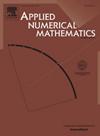用于大型多维特征值计算的克雷洛夫子空间方法
IF 2.4
2区 数学
Q1 MATHEMATICS, APPLIED
引用次数: 0
摘要
本文介绍了一些计算大型稀疏三阶张量的特征管和特征向量(特征切片)的 Krylov 子空间方法。这项工作提供了使用 t-乘积计算一些最大(或最小)特征管和特征切片的投影方法。特别是,我们在非全米情况下使用了张量阿诺迪方法,在 f 全米张量情况下使用了张量兰克佐斯方法。我们还使用张量块阿诺迪方法来逼近大型张量的极值。我们给出了一些计算实例来说明这些方法的有效性。本文章由计算机程序翻译,如有差异,请以英文原文为准。
Krylov subspace methods for large multidimensional eigenvalue computation
In this paper, we describe some Krylov subspace methods for computing eigentubes and eigenvectors (eigenslices) for large and sparse third-order tensors. This work provides projection methods for computing some of the largest (or smallest) eigentubes and eigenslices using the t-product. In particular, we use the tensor Arnoldi's approach for the non-hermitian case and the tensor Lanczos's approach for f-hermitian tensors. We also use the tensor block Arnoldi method to approximate the extreme eigentubes of a large tensor. Computed examples are given to illustrate the effectiveness of these methods.
求助全文
通过发布文献求助,成功后即可免费获取论文全文。
去求助
来源期刊

Applied Numerical Mathematics
数学-应用数学
CiteScore
5.60
自引率
7.10%
发文量
225
审稿时长
7.2 months
期刊介绍:
The purpose of the journal is to provide a forum for the publication of high quality research and tutorial papers in computational mathematics. In addition to the traditional issues and problems in numerical analysis, the journal also publishes papers describing relevant applications in such fields as physics, fluid dynamics, engineering and other branches of applied science with a computational mathematics component. The journal strives to be flexible in the type of papers it publishes and their format. Equally desirable are:
(i) Full papers, which should be complete and relatively self-contained original contributions with an introduction that can be understood by the broad computational mathematics community. Both rigorous and heuristic styles are acceptable. Of particular interest are papers about new areas of research, in which other than strictly mathematical arguments may be important in establishing a basis for further developments.
(ii) Tutorial review papers, covering some of the important issues in Numerical Mathematics, Scientific Computing and their Applications. The journal will occasionally publish contributions which are larger than the usual format for regular papers.
(iii) Short notes, which present specific new results and techniques in a brief communication.
 求助内容:
求助内容: 应助结果提醒方式:
应助结果提醒方式:


